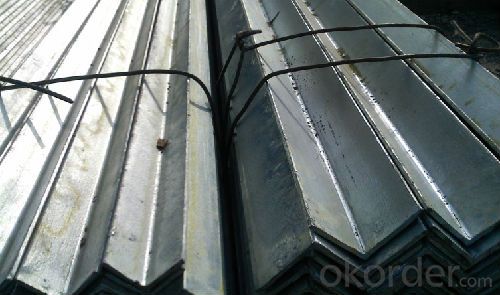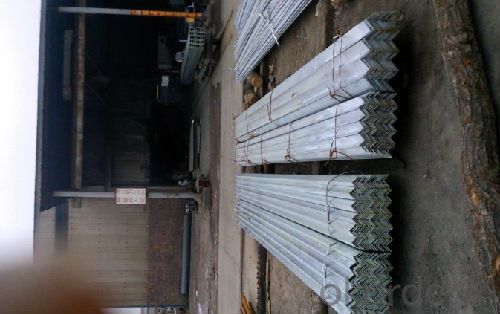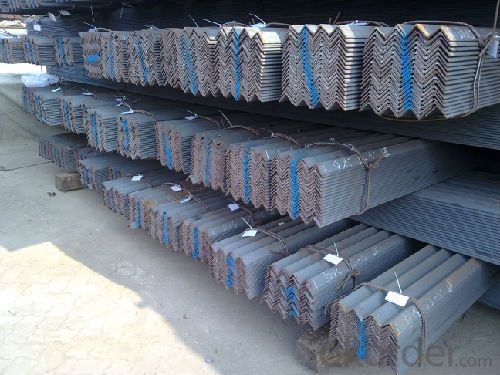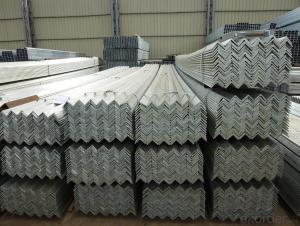Equal Angle Steel Prime Hot Rolled for Construction
- Loading Port:
- Tianjin
- Payment Terms:
- TT or LC
- Min Order Qty:
- 25 m.t.
- Supply Capability:
- 40000 m.t./month
OKorder Service Pledge
OKorder Financial Service
You Might Also Like
Product Description:
OKorder is offering Equal Angle Steel Prime Hot Rolled for Construction at great prices with worldwide shipping. Our supplier is a world-class manufacturer of steel, with our products utilized the world over. OKorder annually supplies products to European, North American and Asian markets. We provide quotations within 24 hours of receiving an inquiry and guarantee competitive prices.
Product Applications:
Equal Angle Steel Prime Hot Rolled for Construction are ideal for structural applications and are widely used in the construction of buildings and bridges, and the manufacturing, petrochemical, and transportation industries.
Product Advantages:
OKorder's Equal Angle Steel Prime Hot Rolled for Construction are durable, strong, and resist corrosion.
Main Product Features:
· Premium quality
· Prompt delivery & seaworthy packing (30 days after receiving deposit)
· Corrosion resistance
· Can be recycled and reused
· Mill test certification
· Professional Service
· Competitive pricing
Product Specifications:
Hot Rolled Equal Angle Steel
1.Professional factory
2.Angle steel Size:20-200MM
3.Angle steel Standard:JIS
4.Materials:SS400
Commodity Size(mm) Theoretical Weight(kg/m)
EQUAL ANGLE 20*20*3 0.889
EQUAL ANGLE 20*20*4 1.145
EQUAL ANGLE 25*25*2.5 0.932
EQUAL ANGLE 25*25*2.7 1.003
EQUAL ANGLE 25*25*3.0 1.124
EQUAL ANGLE 25*25*4.0 1.459
EQUAL ANGLE 30*30*2.5 1.128
EQUAL ANGLE 30*30*3.0 1.373
EQUAL ANGLE 30*30*4.0 1.786
EQUAL ANGLE 35*35*3.0 1.578
EQUAL ANGLE 35*35*4.0 2.072
EQUAL ANGLE 35*35*5.0 2.551
EQUAL ANGLE 38*38*2.5 1.442
EQUAL ANGLE 38*38*3.0 1.719
EQUAL ANGLE 38*38*3.7 2.100
EQUAL ANGLE 38*38*4.0 2.261
EQUAL ANGLE 40*40*3.0 1.852
EQUAL ANGLE 40*40*4.0 2.422
EQUAL ANGLE 40*40*5.0 2.976
EQUAL ANGLE 48*48*3.0 2.190
EQUAL ANGLE 48*48*4.0 2.889
EQUAL ANGLE 48*48*5.0 3.572
EQUAL ANGLE 50*50*3.0 2.332
EQUAL ANGLE 50*50*3.7 2.797
EQUAL ANGLE 50*50*4.0 3.059
EQUAL ANGLE 50*50*5.0 3.770
EQUAL ANGLE 50*50*6.0 4.465
EQUAL ANGLE 56*56*3.0 2.624
EQUAL ANGLE 56*56*4.0 3.446
EQUAL ANGLE 56*56*5.0 4.251
EQUAL ANGLE 60*60*5.0 4.514
EQUAL ANGLE 60*60*6.0 5.369
EQUAL ANGLE 63*63*4.0 3.907
EQUAL ANGLE 63*63*5.0 4.822
EQUAL ANGLE 63*63*6.0 5.721
EQUAL ANGLE 63*63*8.0 7.469
EQUAL ANGLE 63*63*10.0 9.151
EQUAL ANGLE 70*70*4.0 4.372
EQUAL ANGLE 70*70*5.0 5.397
EQUAL ANGLE 70*70*6.0 6.406
EQUAL ANGLE 70*70*7.0 7.398
EQUAL ANGLE 70*70*8.0 8.373
EQUAL ANGLE 75*75*5.0 5.818
EQUAL ANGLE 75*75*6.0 6.905
EQUAL ANGLE 75*75*7.0 7.976
EQUAL ANGLE 75*75*8.0 9.030
EQUAL ANGLE 75*75*10.0 11.089
EQUAL ANGLE 80*80*5.0 6.211
EQUAL ANGLE 80*80*6.0 7.376
EQUAL ANGLE 80*80*7.0 8.525
EQUAL ANGLE 80*80*8.0 9.658
EQUAL ANGLE 80*80*10.0 11.874
EQUAL ANGLE 90*90*6.0 8.350
EQUAL ANGLE 90*90*7.0 9.656
EQUAL ANGLE 90*90*8.0 10.946
EQUAL ANGLE 90*90*9.0 12.081
EQUAL ANGLE 90*90*10.0 13.476
EQUAL ANGLE 90*90*12.0 15.940
EQUAL ANGLE 100*100*6 9.366
EQUAL ANGLE 100*100*7 10.830
EQUAL ANGLE 100*100*8 12.276
EQUAL ANGLE 100*100*9 13.494
EQUAL ANGLE 100*100*10 15.120
EQUAL ANGLE 100*100*12 17.898
EQUAL ANGLE 100*100*14 20.611
EQUAL ANGLE 100*100*16 23.257
EQUAL ANGLE 110*110*7 11.928
EQUAL ANGLE 110*110*8 13.532
EQUAL ANGLE 110*110*10 16.690
EQUAL ANGLE 110*110*12 19.782
EQUAL ANGLE 110*110*14 22.809
EQUAL ANGLE 120*120*10.0 18.055
EQUAL ANGLE 120*120*12.0 21.478
EQUAL ANGLE 125*125*8 15.504
EQUAL ANGLE 125*125*10 19.133
EQUAL ANGLE 125*125*12 22.696
EQUAL ANGLE 125*125*14 26.193
EQUAL ANGLE 130*130*10 19.625
EQUAL ANGLE 130*130*12 23.362
EQUAL ANGLE 140*140*10 21.488
EQUAL ANGLE 140*140*12 25.522
EQUAL ANGLE 140*140*14 29.490
EQUAL ANGLE 140*140*16 33.393
EQUAL ANGLE 150*150*10.0 22.765
EQUAL ANGLE 150*150*12.0 27.130
EQUAL ANGLE 150*150*15.0 33.559
EQUAL ANGLE 160*160*10.0 24.719
EQUAL ANGLE 160*160*12.0 29.391
EQUAL ANGLE 160*160*14.0 33.987
EQUAL ANGLE 160*160*16.0 38.518
EQUAL ANGLE 180*180*12.0 33.159
EQUAL ANGLE 180*180*14.0 35.383
EQUAL ANGLE 180*180*16.0 43.542
EQUAL ANGLE 180*180*18.0 48.634
EQUAL ANGLE 200*200*14.0 42.894
EQUAL ANGLE 200*200*15.0 45.334
EQUAL ANGLE 200*200*16.0 48.680
EQUAL ANGLE 200*200*18.0 54.401
EQUAL ANGLE 200*200*20.0 60.056
EQUAL ANGLE 200*200*22.0 65.281
EQUAL ANGLE 200*200*24.0 71.168
FAQ:
Q1: Why buy Materials & Equipment from OKorder.com?
A1: All products offered byOKorder.com are carefully selected from China's most reliable manufacturing enterprises. Through its ISO certifications, OKorder.com adheres to the highest standards and a commitment to supply chain safety and customer satisfaction.
Q2: How do we guarantee the quality of our products?
A2: We have established an advanced quality management system which conducts strict quality tests at every step, from raw materials to the final product. At the same time, we provide extensive follow-up service assurances as required.
Q3: How soon can we receive the product after purchase?
A3: Within three days of placing an order, we will begin production. The specific shipping date is dependent upon international and government factors, but is typically 7 to 10 workdays.
Q4: What makes stainless steel stainless?
A4: Stainless steel must contain at least 10.5 % chromium. It is this element that reacts with the oxygen in the air to form a complex chrome-oxide surface layer that is invisible but strong enough to prevent further oxygen from "staining" (rusting) the surface. Higher levels of chromium and the addition of other alloying elements such as nickel and molybdenum enhance this surface layer and improve the corrosion resistance of the stainless material.
Q5: Can stainless steel rust?
A5: Stainless does not "rust" as you think of regular steel rusting with a red oxide on the surface that flakes off. If you see red rust it is probably due to some iron particles that have contaminated the surface of the stainless steel and it is these iron particles that are rusting. Look at the source of the rusting and see if you can remove it from the surface.
Images:



- Q:How do you calculate the compression capacity of a steel angle?
- In order to determine the compression capacity of a steel angle, it is necessary to take into account various factors, such as the properties of the steel angle and the applied load. The following step-by-step guide outlines the process for calculating the compression capacity: 1. Begin by assessing the properties of the steel angle. This involves noting the angle's dimensions, including length, thickness, and width. Additionally, it is crucial to be aware of the material properties of the steel, including the yield strength and modulus of elasticity. 2. Next, ascertain the effective length of the steel angle. This refers to the unsupported length of the angle. Considering the effective length is critical as it impacts the angle's buckling behavior when subjected to compression. 3. Proceed to compute the slenderness ratio, which is the ratio of the effective length to the radius of gyration of the steel angle. The radius of gyration can be determined based on the angle's dimensions. The slenderness ratio aids in determining the angle's buckling capacity. 4. Determine the critical stress, which is the stress at which the steel angle commences buckling under compression. Euler's formula can be utilized to calculate the critical stress. This formula is expressed as follows: Critical stress = (π^2 * modulus of elasticity * moment of inertia) / (effective length)^2 5. Lastly, calculate the compression capacity, which denotes the maximum load that the steel angle can endure before buckling. This can be accomplished by multiplying the critical stress by the cross-sectional area of the angle: Compression capacity = critical stress * cross-sectional area By following these outlined steps, it becomes possible to calculate the compression capacity of a steel angle. Nonetheless, it is important to note that this approach is a simplified one. For more precise and accurate calculations, it is recommended to refer to relevant design codes, standards, or seek the guidance of a structural engineer.
- Q:How do steel angles resist corrosion?
- Steel angles resist corrosion through the presence of a protective layer formed on their surface. This layer, known as a patina, is typically composed of iron oxide or iron hydroxide. It acts as a barrier, preventing direct contact between the steel and corrosive elements in the environment, such as moisture or chemicals. Additionally, steel angles can be galvanized or coated with anti-corrosive substances, offering further protection against corrosion.
- Q:How do you prevent steel angles from vibrating?
- There are a few ways to prevent steel angles from vibrating. One effective method is to use vibration damping materials such as rubber pads or isolation mounts between the steel angles and any adjacent surfaces. Another approach is to add additional supports or braces to the steel angles to enhance their stability and reduce any potential vibrations. Additionally, ensuring proper tightening of fasteners and connections can help minimize vibrations.
- Q:Can steel angles be used for playground equipment?
- Yes, steel angles can be used for playground equipment. Steel angles are commonly used in the construction of playground equipment due to their strength, durability, and resistance to corrosion. They provide structural support and stability, making them ideal for ensuring the safety and longevity of playground structures.
- Q:How are steel angles protected against impact damage?
- Steel angles can be protected against impact damage through various means, such as installing protective barriers or guards, using impact-resistant coatings, or incorporating shock-absorbing materials.
- Q:What is the maximum bending moment for a steel angle?
- The maximum bending moment of a steel angle is influenced by various factors, including the angle's dimensions and properties, the load applied, and the support conditions. Typically, the highest stress occurs at the location where the angle is subjected to the maximum bending moment due to the applied load. To determine the maximum bending moment of a steel angle, it is necessary to consider the section modulus (which measures the angle's resistance to bending), the distance between the load and support, and the magnitude and distribution of the load. The section modulus is calculated based on the angle's dimensions, including its thickness, height, and width. Engineers analyze the applied load and support conditions using principles of structural mechanics to ascertain the maximum bending moment of a steel angle. This information is crucial for designing and evaluating the structural integrity of steel angle components in various applications, such as construction, manufacturing, and infrastructure projects. It is important to recognize that the specific dimensions, material properties, and applied load can significantly affect the maximum bending moment. Therefore, it is essential to refer to relevant design codes, standards, or seek guidance from a qualified structural engineer for precise and detailed calculations specific to a particular steel angle.
- Q:How do steel angles compare to wooden or concrete structural elements?
- Steel angles possess several advantages over wooden or concrete structural elements. Firstly, their exceptional strength and durability are well-known. They have the ability to bear heavy loads and resist deformation, making them ideal for supporting large structures or bridges. In contrast, wooden elements are susceptible to rot, warping, and degradation over time, while concrete elements may develop cracks or suffer from corrosion. Moreover, steel angles offer a high level of versatility in terms of design and construction. They can be easily fabricated into various shapes and sizes, allowing for customized solutions to meet different structural needs. This flexibility is not easily attainable with wooden or concrete elements, as they are constrained by natural properties and construction techniques. Furthermore, steel angles provide excellent fire resistance compared to highly flammable wooden elements. Steel does not burn, and its structural integrity remains intact even in high-temperature environments. While concrete also offers fire resistance, steel angles have the added advantage of being lightweight, reducing the overall load on the structure. Another significant benefit of steel angles is their resistance to pests, such as termites or rodents, which can cause severe damage to wooden structures. Steel is impervious to these threats, ensuring long-term stability and reducing maintenance costs. However, there are also some drawbacks to using steel angles. One of the main concerns is the potential for corrosion, particularly in environments with high moisture or chemical exposure. Regular maintenance, including the application of protective coatings or galvanization, is necessary to prevent the formation of rust and maintain the structural integrity of the steel. Moreover, steel angles tend to have a higher initial cost compared to wooden elements. However, their long-term durability and reduced maintenance requirements often result in cost savings over time. In conclusion, steel angles offer numerous advantages over wooden or concrete structural elements, including superior strength, versatility, fire resistance, pest resistance, and long-term durability. However, it is important to consider factors such as corrosion prevention and upfront costs when deciding on the most suitable structural material for a specific project.
- Q:What are the tolerance specifications for steel angles?
- The tolerance specifications for steel angles can vary depending on the specific standards and requirements set by different organizations and industries. However, in general, the tolerance specifications for steel angles typically include measurements for dimensions such as leg length, thickness, and straightness. Leg length tolerance refers to the allowable deviation from the specified leg length of the angle. This tolerance ensures that the angle's legs are within an acceptable range of the desired measurement. For example, a tolerance specification of ±1/8 inch means that the leg length can deviate by up to 1/8 inch in either direction from the specified dimension. Thickness tolerance indicates the permissible deviation in the thickness of the steel angle. This specification ensures that the thickness is consistent and within an acceptable range. It is typically expressed as a percentage or an absolute value. For instance, a tolerance specification of ±10% means that the thickness can deviate by up to 10% above or below the specified dimension. Straightness tolerance ensures that the steel angle is not bent or twisted and meets the required straightness criteria. It is usually measured by the maximum allowable deviation from the straight line. This tolerance specification guarantees that the angle can be easily fitted and aligned during construction or manufacturing processes. It is important to note that the specific tolerance specifications for steel angles may vary depending on the intended application, industry standards, and regulatory requirements. Therefore, it is recommended to refer to the relevant standards, codes, or specifications provided by the manufacturer, industry associations, or governing bodies for accurate and up-to-date information on the tolerance specifications for steel angles.
- Q:Are steel angles resistant to termites and pests?
- No, steel angles are not susceptible to termite and pest infestations as they are made of inorganic materials.
- Q:Can steel angles be used as reinforcements in masonry walls?
- Yes, steel angles can be used as reinforcements in masonry walls. Steel angles are commonly used to provide additional strength and stability to masonry structures. They are often embedded within the mortar joints or anchored into the masonry units to enhance the overall structural integrity of the wall. The steel angles help to distribute and resist the forces acting on the wall, such as lateral loads or bending moments, making them a reliable choice for reinforcement in masonry construction.
1. Manufacturer Overview |
|
|---|---|
| Location | |
| Year Established | |
| Annual Output Value | |
| Main Markets | |
| Company Certifications | |
2. Manufacturer Certificates |
|
|---|---|
| a) Certification Name | |
| Range | |
| Reference | |
| Validity Period | |
3. Manufacturer Capability |
|
|---|---|
| a)Trade Capacity | |
| Nearest Port | |
| Export Percentage | |
| No.of Employees in Trade Department | |
| Language Spoken: | |
| b)Factory Information | |
| Factory Size: | |
| No. of Production Lines | |
| Contract Manufacturing | |
| Product Price Range | |
Send your message to us
Equal Angle Steel Prime Hot Rolled for Construction
- Loading Port:
- Tianjin
- Payment Terms:
- TT or LC
- Min Order Qty:
- 25 m.t.
- Supply Capability:
- 40000 m.t./month
OKorder Service Pledge
OKorder Financial Service
Similar products
New products
Hot products
Related keywords



























